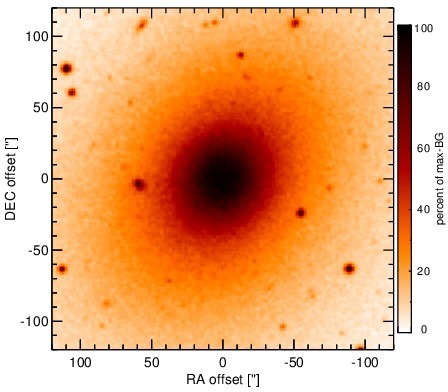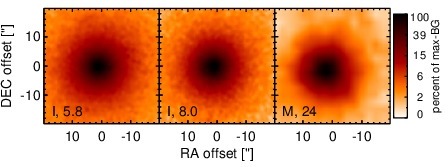Sasmirala Individual Information for NGC 4636
Description
NGC 4636 is one of the X-ray brightest elliptical galaxies in the Virgo cluster at a distance of D = 15.6 ± 2.7 Mpc (NED redshift-independent median). It hosts a broad-line LINER [ho_search_1997-1]. An X-ray point source consistent with the nuclear position is present, but appears very weakly and with a soft spectrum, which disfavours an AGN unless highly obscured [gonzalez-martin_x-ray_2006, gonzalez-martin_fitting_2009, flohic_central_2006, baldi_unusual_2009]. In addition, NGC 4636 features a weak compact radio source with kiloparsec-scale jet-like bicones (PA~ 40∘; [birkinshaw_orientations_1985, stanger_high-resolution_1986, nagar_radio_2000]). The NLR has a compact and a wide outflow component, extending ~ 3arcsec ~ 220 pc towards the north (e.g., [masegosa_nature_2011]). The first ground-based MIR observations of NGC 4636 were performed by [impey_infrared_1986] and [devereux_infrared_1987], but the nucleus remained undetected. In addition, ISO [ferrari_survey_2002, athey_mid-infrared_2002, temi_cold_2004, temi_ages_2005] and Spitzer/IRAC, IRS and MIPS observed this object. The corresponding IRAC and MIPS images show extended host emission without any separable nuclear component. Our unresolved nuclear MIPS 24 μm flux measurement, therefore, provides a significantly lower value than the total flux given in [temi_spitzer_2009]. The IRS LR staring-mode spectrum shows weak silicate 10 and 18 μm emission and a blue spectral slope in νFν-space but no PAH features, typical for an inactive elliptical (see also [bressan_spitzer_2006]). The nuclear region of NGC 4636 was observed with VISIR in the PAH2_2 during three nights in 2010, but nothing was detected (unpublished, to our knowledge). All derived flux upper limits are higher than the Spitzer spectrophotometry, which we, therefore, use to derive an upper limit on the 12 μm continuum emission of any AGN in NGC 4636.
- [athey_mid-infrared_2002] Alex Athey, Joel Bregman, Jesse Bregman, Pasquale Temi, and Marc Sauvage. Mid-infrared observation of mass loss in elliptical galaxies . ApJ , 571 pp. 272–281, May 2002.
- [baldi_unusual_2009] A. Baldi, W. Forman, C. Jones, R. Kraft, P. Nulsen, E. Churazov, L. David, and S. Giacintucci. The unusual x-ray morphology of NGC 4636 revealed by deep chandra observations: Cavities and shocks created by past active galactic nucleus outbursts . ApJ , 707 pp. 1034–1043, December 2009.
- [birkinshaw_orientations_1985] M. Birkinshaw and R. L. Davies. The orientations of the rotation axes of radio galaxies. i - radio morphologies of bright elliptical galaxies . ApJ , 291 pp. 32–44, April 1985.
- [bressan_spitzer_2006] A. Bressan, P. Panuzzo, L. Buson, M. Clemens, G. L. Granato, R. Rampazzo, L. Silva, J. R. Valdes, O. Vega, and L. Danese. Spitzer IRS spectra of virgo early-type galaxies: Detection of stellar silicate emission . ApJL , 639 pp. L55–L58, March 2006.
- [devereux_infrared_1987] Nicholas A. Devereux, E. E. Becklin, and Nick Scoville. Infrared characteristics of the nuclei of normal galaxies . ApJ , 312 pp. 529–541, January 1987.
- [ferrari_survey_2002] F. Ferrari, M. G. Pastoriza, F. D. Macchetto, C. Bonatto, N. Panagia, and W. B. Sparks. Survey of the ISM in early-type galaxies. IV. the hot dust component . A&A , 389 pp. 355–366, July 2002.
- [flohic_central_2006] Hélène M. L. G. Flohic, Michael Eracleous, George Chartas, Joseph C. Shields, and Edward C. Moran. The central engines of 19 LINERs as viewed by chandra . ApJ , 647 pp. 140–160, August 2006.
- [gonzalez-martin_fitting_2009] O. González-Martín, J. Masegosa, I. Márquez, and M. Guainazzi. Fitting liner nuclei within the active galactic nucleus family: A matter of obscuration? . ApJ , 704 pp. 1570–1585, October 2009.
- [gonzalez-martin_x-ray_2006] O. González-Martín, J. Masegosa, I. Márquez, M. A. Guerrero, and D. Dultzin-Hacyan. X-ray nature of the LINER nuclear sources . A&A , 460 pp. 45–57, December 2006.
- [ho_search_1997-1] Luis C. Ho, Alexei V. Filippenko, and Wallace L. W. Sargent. A search for ``Dwarf'' seyfert nuclei. III. spectroscopic parameters and properties of the host galaxies . ApJS , 112 pp. 315, October 1997.
- [impey_infrared_1986] C. D. Impey, C. G. Wynn-Williams, and E. E. Becklin. Infrared studies of elliptical galaxies. i - an optically selected sample . ApJ , 309 pp. 572–592, October 1986.
- [masegosa_nature_2011] J. Masegosa, I. Márquez, A. Ramirez, and O. González-Martín. The nature of nuclear hα emission in LINERs . A&A , 527 pp. 23, March 2011.
- [nagar_radio_2000] Neil M. Nagar, Heino Falcke, Andrew S. Wilson, and Luis C. Ho. Radio sources in low-luminosity active galactic nuclei. i. VLA detections of compact, flat-spectrum cores . ApJ , 542 pp. 186–196, October 2000.
- [stanger_high-resolution_1986] V. J. Stanger and R. S. Warwick. High-resolution x-ray and radio observations of the giant elliptical galaxies NGC 4636 and 4649 . MNRAS , 220 pp. 363–376, May 1986.
- [temi_ages_2005] Pasquale Temi, William G. Mathews, and Fabrizio Brighenti. The ages of elliptical galaxies from mid-infrared emission . ApJ , 622 pp. 235–243, March 2005.
- [temi_cold_2004] Pasquale Temi, Fabrizio Brighenti, William G. Mathews, and Jesse D. Bregman. Cold dust in early-type galaxies. i. observations . ApJS , 151 pp. 237–269, April 2004.
- [temi_spitzer_2009] Pasquale Temi, Fabrizio Brighenti, and William G. Mathews. Spitzer observations of passive and star-forming early-type galaxies: An infrared color-color sequence . ApJ , 707 pp. 890–902, December 2009.
Images

Optical image (DSS, red filter). Displayed are the central 4 arcmin with North being up and East to the left. The colour scaling is linear with white corresponding to the median background (BG) and black to the 0.01% pixels with the highest intensity.

Spitzer MIR images. Displayed are the inner 40 arcsec with North being up and East to the left. The colour scaling is logarithmic with white corresponding to median BG and black to the 0.1% pixels with the highest intensity. The label in the bottom left states instrument and central wavelength of the filter in micron (I: IRAC, M: MIPS).
SEDs


MIR SED. The description of the symbols in all the SED plots (where present) is the following: Grey crosses and solid lines mark the Spitzer/IRAC, MIPS and IRS data. The colour coding of the other symbols is as follows: green for COMICS, magenta for Michelle, blue for T-ReCS and red for VISIR data. Darker-coloured solid lines mark spectra of the corresponding instrument. The black filled circles mark the nuclear 12 and 18 micron continuum emission estimate from the data (where present). The ticks on the top axis mark positions of common MIR emission lines, while the light grey horizontal bars mark wavelength ranges affected by the silicate 10 and 18 micron features.